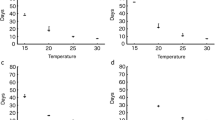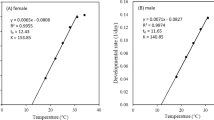Summary
The sum of effective temperatures (SET) and lower development threshold (LDT) were established for eggs and/or pupae of central European populations of 20 species of chrysopid, coccinellid, hemerobiid, and syrphid predators of aphids. LDT ranged between 5.6° and 12.2°C, SET between 38.3 and 140.9 day degrees (dd), with broad overlap among stages and taxa. When LDT was plotted against SET, the data for both eggs and pupae were scattered along a single regression line which predicted a 0.47°C decrease in LDT per 10 dd increase in SET (r=-0.77, p<0.001). A regression calculated from published data from all over the world predicted a 0.24°C/10 dd decrease in LDT, and the data were more scattered (r=-0.38, p<0.01). This is perhaps the first report on the functional relationship between LDT and SET at the interspecific level. The species and stages differed in typical development length (VDL) and in the extent of its deceleration by low temperatures (DD). DD increased with increasing VDL, but the relative effect of low temperature on development length (DD/VDL ratio) reflected thermal adaptations consistent with the life history of the species. Polyvoltine species were less affected by low temperatures than monovoltine species, particularly the thermophilic ones.
Similar content being viewed by others
References
Bänsch R (1964) Vergleichende Untersuchungen zur Biologie und zum Beutefangverhalten aphidivorer Coccinelliden, Chrysopiden und Syrphiden. Zool Jb Syst 91:271–340
Benestad E (1970) Laboratory experiments on the biology of Syrphus corollae (Fabr.) (Dipt., Syrphidae). Norsk Entomol Tidsskr 17:77–85
Butler GD (1982) Development time of Coccinella septempunctata in relation to constant temperatures (Col.: Coccinellidae). Entomophaga 27:349–353
Butler GD, Dickerson WA (1972) Life cycle of the convergent lady beetle in relation to temperature. J Econ Entomol 65:1508–1509
Butler GD, Ritchie PL (1970) Development of Chrysopa carnea at constant and fluctuating temperatures. J Econ Entomol 63:1028–1030
Hinke F (1975) Autökologische Untersuchungen an mitteleuropäischen Neuropteren. Zool Jb Syst 102:303–330
Hodek I (1958) Influence of temperature, relative humidity and photoperiodicity on the speed of development of Coccinella septempunctata L. Čas Čs Spol Entomol 55:121–141
Honěk A (1980) Population density of aphids at the time of settling and ovariole maturation in Coccinella septempunctata (Col.: Coccinellidae). Entomophaga 25:427–430
Honěk A (1983) Factors affecting the distribution of larvae of aphid predators (Col., Coccinellidae and Dipt., Syrphidae) in cereal stands. Z Angew Entomol 95:336–343
Howe RW (1967) Temperature effects on embryonic development in insects. Annu Rev Entomol 12:15–42
Ito K, Iwao S (1977) Oviposition behavior of a syrphid Episyrphus balteatus, in relation to aphid density on the plant. Jap J Appl Entomol Zool 21:130–134
Kawauchi S (1983) The threshold temperature and thermal constant for development from the egg to the adult form of Coccinella septempunctata brucki, Propylea japonica and Scymnus (Pullus) hoffmani (Coleoptera, Coccinellidae). Kurume Univ J 32:45–51
Nechols JR, Tauber MJ, Tauber CA (1987) Geographical variability in ecophysiological traits controlling dormancy in Chrysopa oculata (Neuroptera: Chrysopidae). J Insect Physiol 33:627–633
Neuenschwander P (1975) Influence of temperature and humidity on the immature stages of Hemerobius pacificus. Env Entomol 4:215–220
Obrycki JJ, Tauber MJ (1978) Thermal requirements for development of Coleomegilla maculata (Coleoptera: Coccinellidae) and its parasite Perilitus coccinellae (Hymenoptera: Braconidae). Can Entomol 110:407–412
Obrycki JJ, Tauber MJ (1982) Thermal requirements for development of Hippodamia convergens (Coleoptera: Coccinellidae) Ann Entomol Soc Amer 75:678–683
Obrycki JJ, Tauber MJ (1983) Phenology of three coccinellid species: Thermal requirements for development. Ann Entomol Soc Amer 74:31–36
Okrouhlá M, Chakrabarti S, Hodek I (1983) Developmental rate and feeding capacity in Cheilomenes sulphurea (Coleoptera: Coccinellidae). Věst Čs Společ Zool 47:105–117
Sakuratani Y, Shimizu K, Shirouchi E (1986) Adult emergence of Coccinella septempunctata bruckii Mulsant (Coleoptera: Coccinellidae) in winter in central Japan. Appl Entomol Zool 21:476–478
Sanders W (1979) Das Eiablageverhalten der Schwebefliege Syrphus corollae Fabr., in Abhängigkeit von der Größe der Blattlauskolonie. Z Angew Entomol 66:217–232
Sheldon JK, MacLeod EG (1974) Studies on the biology of the Chrysopidae V. The developmental and reproductive maturation rates of Chrysopa carnea (Neuroptera: Chrysopidae). Entomol News 85:159–169
Szentkirályi F (1986) Niche segregation between chrysopid and hemerobiid subguilds. In: Hodek I (ed) Ecology of aphidophaga 2 Academia, Praha, pp 297–302
Tauber MJ, Tauber CA (1974) Thermal accumulation, diapause and oviposition in a conifer-inhabiting predator, Chrysopa harrisii (Neuroptera). Can Entomol 106:969–978
Tauber CA, Tauber MJ, Nechols JR (1987) Thermal requirements for developent in Chrysopa oculata: a geographically stable trait. Ecology 68:1479–1487
Author information
Authors and Affiliations
Rights and permissions
About this article
Cite this article
Honěk, A., Kocourek, F. Thermal requirements for development of aphidophagous Coccinellidae (Coleoptera), Chrysopidae, Hemerobiidae (Neuroptera), and Syrphidae (Diptera): some general trends. Oecologia 76, 455–460 (1988). https://doi.org/10.1007/BF00377042
Received:
Issue Date:
DOI: https://doi.org/10.1007/BF00377042




